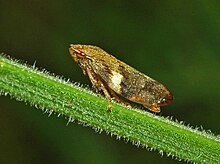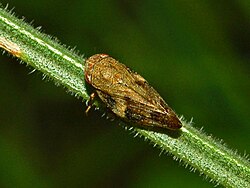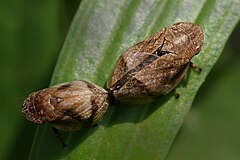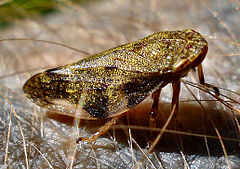259:
33:
54:
359:
338:
350:
269:
The adults of these large 'froghoppers' reach 9–10 millimetres (0.35–0.39 in) of length, the females are usually slightly larger than the males. The basic coloration of the body is usually brown. Their front wings wear two distinct clear patches on the margins. Head and pronotum have a median
321:
To lay eggs, the females migrate to the herb layers. The eggs overwinter and hatch the larvae in the following spring. The larvae live in stems and leaves of herbaceous plants inside the typical foam nest, that protects them against enemies and provide necessary moisture and temperature for their
249:
These 'froghoppers' inhabit dry and moist habitats of lowlands and mountainous areas, forest edges, hedgerows, meadows, gardens and parks, from the lowlands up to mountains at an elevation up to 1,500 metres (4,900 ft) above sea level.
368:
431:
Andrew
Hamilton: The Spittlebuqs of Canada (Homoptera, Cercopidae). The Insects and Arachnids of Canada, Part 10. Biosystematics Research Institute, Ottawa, Ontario, Research Branch Agriculture Canada, Publication 1740. Ottawa
460:
Walter J. Le Quesne: Handbooks for the identification of
British Insects. Vol. II. part 2 (a). Hemiptera. Cicadomorpha (excluding Deltocephalinae and Typhlocybinae). Londyn: Royal Entomological Society of London, 1965, s.
371:
375:
374:
370:
369:
376:
444:
H. Nickel: The leafhoppers and planthoppers of
Germany (Hemiptera, Auchenorrhyncha): Patterns and strategies in a highly diverse group of phytophagous insects. Pensoft, Sofia and Moskau, 2003,
373:
760:
622:
513:
695:
372:
721:
314:
species, meaning it feeds on several kind of plants. The adults primarily feed on deciduous trees, while larvae prefer herbaceous plants (
819:
656:
449:
507:
502:
420:
726:
471:
747:
824:
581:
674:
53:
765:
687:
282:
They can be encountered from May through
October on bushes and on several species of trees, especially willows (
482:
409:
814:
524:
274:). The legs are strongly developed and fit to jump. Tibiae of the rear pair of legs carry several spines.
175:
586:
158:
337:
258:
630:
562:
32:
739:
184:
48:
786:
607:
445:
791:
230:
358:
773:
115:
682:
669:
315:
808:
214:
125:
238:
612:
752:
734:
708:
556:
311:
547:
349:
135:
661:
643:
234:
105:
85:
65:
497:
573:
594:
541:
778:
700:
599:
302:
713:
225:
This species is quite common and widespread. It is present in most of
290:
271:
226:
95:
75:
518:
648:
296:
284:
257:
635:
270:
keel. The head has a pair of compound eyes and two simple eyes (
522:
472:
FIELD GUIDE TO INSECTS OF BRITAIN AND NORTHERN EUROPE
531:
8:
519:
31:
20:
393:
333:
213:, is a species belonging to the family
241:. It is naturalized in North America.
7:
688:f40c58eb-7fa6-457b-93e0-f07d46bfa66f
440:
438:
405:
403:
401:
399:
397:
14:
366:
357:
348:
336:
326:has only one generation a year.
52:
514:Cercopoidea Organised On Line.
1:
512:Soulier-Perkins, A. (2013)
841:
211:European alder spittle bug
820:Insects described in 1805
190:
183:
164:
157:
49:Scientific classification
47:
39:
30:
23:
266:
300:species) and poplar (
261:
683:Fauna Europaea (new)
825:Hemiptera of Europe
16:Species of true bug
267:
802:
801:
787:Open Tree of Life
525:Taxon identifiers
377:
294:species), alder (
288:species), birch (
229:, in the eastern
202:
201:
832:
795:
794:
782:
781:
769:
768:
756:
755:
753:NHMSYS0020705221
743:
742:
730:
729:
717:
716:
704:
703:
691:
690:
678:
677:
665:
664:
652:
651:
639:
638:
626:
625:
616:
615:
603:
602:
590:
589:
577:
576:
567:
566:
565:
552:
551:
550:
520:
485:
480:
474:
468:
462:
458:
452:
442:
433:
429:
423:
418:
412:
407:
379:
378:
361:
352:
340:
231:Palearctic realm
170:
57:
56:
35:
21:
840:
839:
835:
834:
833:
831:
830:
829:
805:
804:
803:
798:
790:
785:
777:
774:Observation.org
772:
764:
759:
751:
746:
738:
733:
725:
720:
712:
707:
699:
694:
686:
681:
673:
668:
660:
655:
647:
642:
634:
629:
621:
619:
611:
606:
598:
593:
585:
580:
572:
570:
563:Aphrophora alni
561:
560:
555:
546:
545:
540:
533:Aphrophora alni
527:
494:
489:
488:
481:
477:
469:
465:
459:
455:
443:
436:
430:
426:
419:
415:
408:
395:
390:
383:
380:
367:
362:
353:
344:
341:
332:
324:Aphrophora alni
308:Aphrophora alni
280:
263:Aphrophora alni
256:
247:
223:
206:Aphrophora alni
179:
172:
168:Aphrophora alni
166:
153:
116:Auchenorrhyncha
51:
41:Aphrophora alni
25:Aphrophora alni
17:
12:
11:
5:
838:
836:
828:
827:
822:
817:
807:
806:
800:
799:
797:
796:
783:
770:
757:
744:
731:
718:
705:
692:
679:
670:Fauna Europaea
666:
653:
640:
627:
617:
604:
591:
578:
568:
553:
537:
535:
529:
528:
523:
517:
516:
510:
505:
500:
493:
492:External links
490:
487:
486:
475:
463:
453:
434:
424:
421:Fauna europaea
413:
392:
391:
389:
386:
385:
384:
381:
365:
363:
356:
354:
347:
345:
342:
335:
331:
328:
316:dicotyledonous
279:
276:
255:
252:
246:
243:
222:
219:
200:
199:
198:
197:
188:
187:
181:
180:
173:
162:
161:
155:
154:
147:
145:
141:
140:
133:
129:
128:
123:
119:
118:
113:
109:
108:
103:
99:
98:
93:
89:
88:
83:
79:
78:
73:
69:
68:
63:
59:
58:
45:
44:
37:
36:
28:
27:
15:
13:
10:
9:
6:
4:
3:
2:
837:
826:
823:
821:
818:
816:
815:Aphrophoridae
813:
812:
810:
793:
788:
784:
780:
775:
771:
767:
762:
758:
754:
749:
745:
741:
736:
732:
728:
723:
719:
715:
710:
706:
702:
697:
693:
689:
684:
680:
676:
671:
667:
663:
658:
654:
650:
645:
641:
637:
632:
628:
624:
618:
614:
609:
605:
601:
596:
592:
588:
583:
579:
575:
569:
564:
558:
554:
549:
543:
539:
538:
536:
534:
530:
526:
521:
515:
511:
509:
506:
504:
501:
499:
496:
495:
491:
484:
479:
476:
473:
467:
464:
457:
454:
451:
450:954-642-169-3
447:
441:
439:
435:
428:
425:
422:
417:
414:
411:
406:
404:
402:
400:
398:
394:
387:
364:
360:
355:
351:
346:
339:
334:
329:
327:
325:
322:development.
319:
317:
313:
309:
305:
304:
299:
298:
293:
292:
287:
286:
277:
275:
273:
265:, dorsal view
264:
260:
253:
251:
244:
242:
240:
236:
232:
228:
220:
218:
216:
215:Aphrophoridae
212:
208:
207:
195:
194:Cercopis alni
192:
191:
189:
186:
182:
177:
171:
169:
163:
160:
159:Binomial name
156:
152:
151:
146:
143:
142:
139:
138:
134:
131:
130:
127:
126:Aphrophoridae
124:
121:
120:
117:
114:
111:
110:
107:
104:
101:
100:
97:
94:
91:
90:
87:
84:
81:
80:
77:
74:
71:
70:
67:
64:
61:
60:
55:
50:
46:
42:
38:
34:
29:
26:
22:
19:
532:
478:
470:Bob Gibbons
466:
456:
427:
416:
410:British Bugs
323:
320:
307:
306:species).).
301:
295:
289:
283:
281:
268:
262:
248:
239:North Africa
224:
221:Distribution
210:
205:
204:
203:
196:Fallén, 1805
193:
167:
165:
150:A. alni
149:
148:
136:
43:, side view
40:
24:
18:
735:NatureServe
709:iNaturalist
557:Wikispecies
508:ITIS Report
312:polyphagous
254:Description
809:Categories
503:Aphrophora
483:Commanster
388:References
137:Aphrophora
112:Suborder:
86:Arthropoda
237:, and in
235:Near East
233:, in the
144:Species:
106:Hemiptera
72:Kingdom:
66:Eukaryota
740:2.115416
595:BugGuide
571:BioLib:
548:Q1355576
542:Wikidata
185:Synonyms
122:Family:
82:Phylum:
76:Animalia
62:Domain:
701:2016266
636:2865796
330:Gallery
303:Populus
278:Biology
245:Habitat
178:, 1805)
132:Genus:
102:Order:
96:Insecta
92:Class:
792:197764
766:295201
727:956007
714:213962
675:239365
662:259749
649:APHRAL
620:COOL:
587:198947
574:102861
498:Biolib
448:
343:Mating
291:Betula
272:ocelli
227:Europe
209:, the
176:Fallén
657:EUNIS
600:61098
461:8-11.
432:1982.
310:is a
297:Alnus
285:Salix
779:8518
761:NCBI
722:ITIS
696:GBIF
644:EPPO
623:2523
613:FKF2
582:BOLD
446:ISBN
382:Clip
748:NBN
631:EoL
608:CoL
318:).
811::
789::
776::
763::
750::
737::
724::
711::
698::
685::
672::
659::
646::
633::
610::
597::
584::
559::
544::
437:^
396:^
217:.
174:(
Text is available under the Creative Commons Attribution-ShareAlike License. Additional terms may apply.




